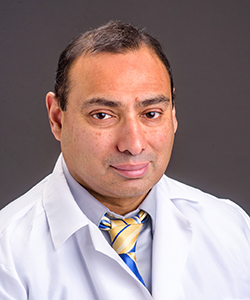August 20, 2025

Stroke — a blockage in blood flow to the brain — is not a new medical phenomenon. And if you’re like most people, you probably filed the idea of having a stroke in your “something to worry about when you get older” pile.

The problem is that strokes are now happening more frequently in younger adults. The Centers for Disease Control and Prevention (CDC) report a 15% increase in strokes among people under age 65.
“If you consider the entire population of younger adults, the risk of stroke is still low — much lower than the risk of stroke in the elderly patient population,” says MU Health Care vascular neurologist Adnan I. Qureshi, MD. “But strokes are occurring more often in younger adults, and it’s concerning. For every 10 stroke patients we treat, two are in the younger age group.”
To help young and middle-aged adults understand their risk for stroke and recognize the signs, Dr. Qureshi shares what researchers and medical experts have uncovered about stroke in this population.
Signs of Stroke in Young People
Signs of stroke in younger adults can be similar to stroke signs in older adults:
- Confusion
- Facial drooping
- Loss of balance and dizziness
- Trouble speaking
- Vision changes
- Weakness or numbness in your arms
However, the signs of stroke in younger people — especially young women — tend to be more vague, causing:
- Increased fatigue
- Migraine headaches
- Trouble thinking clearly or quickly
“Many younger women are eventually diagnosed with stroke after having nonspecific symptoms such as confusion or headaches — things you may not immediately connect with stroke,” Dr. Qureshi says. “People of any age who get migraines are at increased risk for stroke, and younger women are at the highest risk for migraines.”
If you suspect a stroke, it’s critical to get care quickly. Doctors can use medication to break up the clot or perform a thrombectomy — a procedure to remove the clot and restore blood flow to the brain.
“The good news is that younger individuals have a greater ability to cope with stroke recovery than older individuals,” Dr. Qureshi says. “But having a stroke does increase your lifetime risk of having another one.”
Why Are Strokes Happening More Often in Younger Adults?
There have always been factors that increase the risk of stroke for younger adults, such as:
- Substance use: Smoking and illicit drugs such as cocaine and amphetamines are known to increase the risk of stroke.
- Rare blood vessel problems: Conditions such as sickle cell disease and arterial dissection (a tear in the inner wall of a blood vessel) are often associated with stroke in younger people.
However, changing health and environmental factors may be contributing to the recent increase in strokes. The biggest problem? Younger adults don’t tend to recognize their risk.
“An increasing number of strokes in the older population makes sense because that population is growing in size and life expectancy,” Dr. Qureshi says. “However, the increase in strokes in the younger population has been unexpected, even in the medical community.”
He says factors possibly contributing to increased stroke incidence in younger people may include:
1. Undetected Heart Issues
Early- and mid-adulthood are busy times. You are shaping and progressing your career. You may be building and caring for a family. All that responsibility can be distracting and make it easy to miss the early signs of heart disease. Researchers also report a significant rise in cardiovascular risk factors, such as diabetes and obesity, in American adults under the age of 44.
The problem is that cardiovascular risk factors are also risk factors for stroke. Stroke risk is often negatively affected by:
- High blood pressure
- High cholesterol levels, especially your LDL (“bad”) cholesterol
- Poor blood sugar management and diabetes control
“Most patients in this age group don’t feel vulnerable, which can translate into missed signs of heart disease and elevated stroke risk,” Dr. Qureshi says. “The medical system also needs to provide the same level of scrutiny to younger adults as they do with older patients, especially for cardiovascular health.”
2. Increasing Incidence of Cancer
Certain types of cancer are becoming more common in younger adults, and experts are finding a growing connection with stroke.
“Cancer-related strokes are clearly increasing, particularly in younger patients,” Dr. Qureshi says. “Even if you have none of the other classical stroke risk factors, a cancer diagnosis immediately increases your risk.”
The types of cancer most strongly associated with a higher risk of stroke include:
- Abdominal (stomach) cancer
- Breast cancer
- Colorectal cancer
- Lung cancer
- Prostate cancer
“The connection works both ways,” Dr. Qureshi says. “If you have a stroke with no apparent cause, doctors now realize they need to look for undiagnosed cancer.” He adds that the next step in research is figuring out what can be done to reduce the risk of stroke in younger people who are newly diagnosed with cancer.
3. Risks Associated With Childbearing Years
It’s well-established that women who are pregnant or in the postpartum period are at higher risk for stroke — they are three times more likely to have a stroke than nonpregnant women of a similar age. But the incidence of pregnancy-related strokes is rising, and there’s not a lot of data explaining why.
Dr. Qureshi says some information suggests that the recent rise may have something to do with the increasing rate of pregnancy at later ages. According to National Center for Health Statistics, women are giving birth and having their first child an average of five and six years later (respectively) than they were 50 years ago. In 2022, the number of women giving birth at age 45 and older increased 12% from the previous year.
“We don’t know for sure whether the higher rate of pregnancy-related strokes has to do with advanced maternal age or our ability to better recognize strokes in these patients,” Dr. Qureshi says. “But our previous research shows that people who are pregnant older than 35 have a higher risk of cardiovascular events in their lifetime, and therefore a higher risk of stroke.”
Women in this age group may also be at increased risk of having a stroke if they take oral contraceptives containing a high dose of estrogen. “The newest generation of oral contraceptive have a much lower risk than previous products,” Dr. Qureshi says. “But women should be aware that there is still a slight stroke risk associated with these drugs.”
4. Changing Demographics
Certain ethnicities — specifically Hispanic and African American — tend to have an increased risk of stroke, according to Dr. Qureshi. “These ethnicities have a higher risk of blood pressure, diabetes and high cholesterol,” he says. “Those factors are likely driving the risk for stroke.”
As those populations increase in the United States, so might the risk of stroke among younger adults. The 2020 Census showed that since 2010, the number of Hispanic and African American people in the U.S. increased. The Hispanic or Latino population grew by 23%. The Black or African American population grew nearly 6%.
How to Reduce Your Risk of Stroke
There’s no widespread screening for stroke in younger patients, so Dr. Qureshi says recognizing and addressing the potential risk factors for stroke is a critical first step. He recommends taking these steps:
- Identify cardiovascular risk factors: Know your blood pressure and cholesterol numbers, and adjust your lifestyle to manage your blood pressure, blood sugar and weight.
- Know your family history: If a first-degree relative, such as a parent or sibling, had a stroke, it could increase your risk — especially if they had a stroke at a young age.
- Screen for cancer: Stay current on recommended cancer screenings to reduce the risk of cancer-associated stroke.
“Awareness is vital,” Dr. Qureshi says. “Recognizing that any adult can have a stroke will hopefully make you more likely to notice the symptoms and get prompt medical attention.”
Next Steps and Useful Resources
- Stroke and heart disease are closely related. Check your heart health with a Love Your Heart Cardiac Screening.
- Want more? Learn about our advanced stroke care services.


